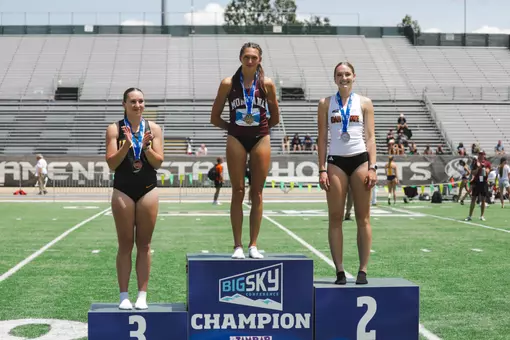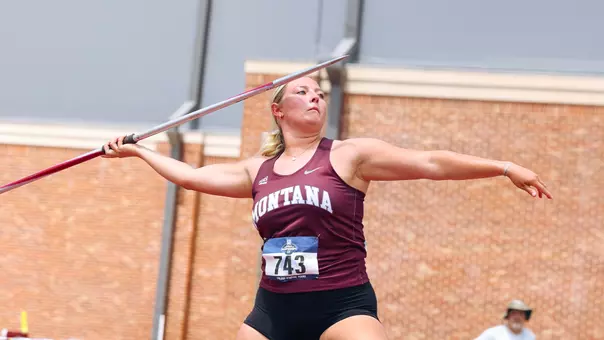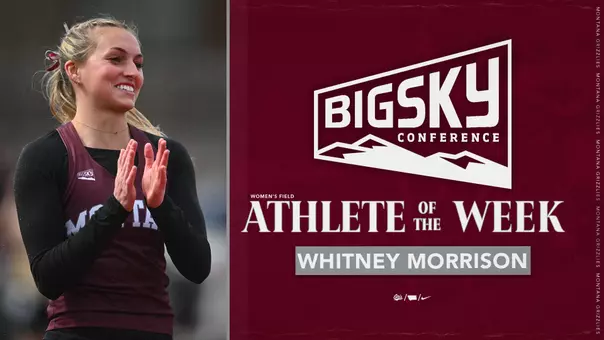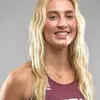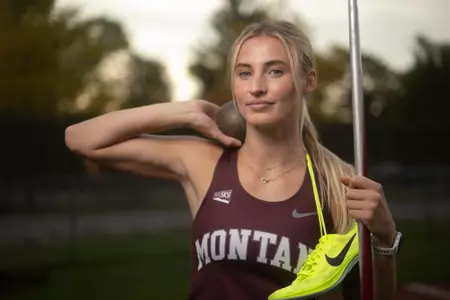
Photo by: Tommy Martino/UM Athletics
Stayner gives back, donates bone marrow through NMDP
4/18/2024 4:19:00 PM | Women's Track and Field
Brooke Stayner did what so many other students do on a daily basis while crossing the oval last spring. She saw a group of students out collecting signatures, and she kept walking on her way to class.
The group of students happened to be her peers in the Montana athletic department. The football team, participating in a registry with the National Marrow Donor Program (NMDP), were looking to find potential donors to connect with patients in need around the country.
When Stayner passed by a second time, something told her that she needed to add her signature to the list. The freshman had heard of the program before, and knew that there was a less than 1 percent chance she would be matched. She stopped by, filled out the paperwork, and left the oval that day thinking she would never hear about it again.
Six months later, she received a text. It told her that she was a potential match with a patient in need. They asked her if she was still interested in the process.
In a moment, the healthy 19-year old had been thrust into a completely new world. She took a phone call to discuss the process, and then had her mother, Kristin, join for a second call. The staff at NMDP walked her through what the next six months of her life might look like, and laying out what would come next in the process.
Blood draws, physicals, interviews, more blood draws. It wouldn't be an easy process. But the people at NMDP, who have completed more than 120,000 transplants since 1987, know this. They asked about Brooke, about her life, about whether this would even be a possibility for her.
She agreed to sign up for the program. When she went to her first physical, the doctor told her that they had done many physicals for the program and none of them had made it to the final donation stage of the process.
Time continued on and Stayner found herself donating blood for the first time. Every step of the way, her family was there with her, helping to guide her through all of the decisions that needed to be made.
"Specifically with my family and I there were a lot of discussions," Stayner said. "It's not super common that you get matched all the way through the process. I think a lot of people receive that first text. Then that first blood draw rolls around and you kind of think, oh I'm probably still not a match."
She continued on through the process, donating several more times. After initially signing up in the spring and thinking that she may never receive the call, Stayner was now being called upon to donate blood while competing in her sophomore season of indoor track.
Stayner is also a integrative physiology major with a biology minor. The pairing comes with a heavy course load for someone getting all of the prerequisites for medical school. The physical taxation of the blood draws and mental fatigue was one thing, but the emotional toll of not knowing if she would be a match at the end of it all added another layer.
Then, she received the call.
"They called me and said you've been matched and the doctor thinks you're the best match," Stayner said. "Here's the date, it will be done in Seattle. The date was five days before the Big Sky Indoor Championships."
Now, the star athlete faced the toughest decision of the entire process. The procedure is invasive, and would completely end any thoughts she had of competing at the Big Sky Indoor meet.
She had a good indoor season, and was expected to score for her team at the conference championships. She certainly felt an obligation to her coaches and teammates to be in Spokane for the event, but now there was also an obligation to a faceless woman that she had never met.
The woman is 47 years old, based in the United States, and has acute myeloid leukemia. These are the only facts that Stayner gets to know about the potential recipient.
Stayner talked with her parents yet again. Her mother, Kristin, had been on every phone call with her and helped her through every step of the process. "She's my favorite person ever," Stayner said, and it was with her parents that she came to the decision. She would do the donation, but asked if there was any chance that it could be pushed back a week.
The NMDP said the patient was stable, that they could wait, and scheduled everything for the week after the Big Sky Indoor Championships. She would get the chance to hold up her obligations to both her team, and to this woman.
"The fact that she's 47, which is a few years younger than my mom, and she might have kids, and she might have, you know, you think about those things," Stayner said. "So for me it was easy to put myself in that position of, I love my sport and love college and the experience I get by doing collegiate athletics, but it was easy to put myself in the shoes of this woman's kid and knowing I would do anything to save my own mom."
Stayner competed in Spokane and was the only female Grizzly to score points in multiple events, finishing 6th in the pentathlon and 7th in the high jump. She finished up the event on Saturday and returned to Missoula. Then on Sunday, she began the steps leading up to donation.
It started with a medication commonly given to cancer patients that builds immunity. In the process, it leeches all of the major stem cells out of your bones, leading to aches and pains. She took that for five days before flying to Spokane for the procedure.
There are different types of donations that can be performed, PBSC or Marrow. According to the NMDP, about 90 percent of donations are PBSC, which is the type that Stayner performed.
Needles are inserted into both arms, splinting one of them to keep you from moving. Unlike a typical IV, the needle remains in your arm for the entire procedure. It pulls the blood out, passes it through a machine to separate blood-forming cells, and then is filtered back in through the other arm.
Nine hours later, Stayner had completed the donation.
"At the end of those nine hours, getting to hold that bag of millions of stem cells. It's an interesting process because it's so valuable, they take it so seriously," Stayner said. "They immediately had someone grab the bag of stem cells and they can go anywhere around the country. They get in a car, go on planes, immediately. It's really cool to see the impact. It's such an amazing program."

The procedure had been completed, and the bag of stem cells was carried away to an unnamed location for a second procedure with the unnamed woman. Now, Stayner was left with the recovery process.
It takes about a month to recover, on average, and can take much longer depending on the person. The immune system is weakened, and back pain, fatigue, muscle aches, and dizziness are all common. Side effects that aren't conducive to performing athletically at a high level.
Stayner had the support of her coaching staff through the process, though, and only missed a few practices in the time between the indoor and outdoor seasons.
"That's Brooke. She's a high-quality young lady and has so much going for her," head coach Doug Fraley said. "When I heard that she was doing this, it wasn't a surprise at all, that's just the kind of person that she is. To have her do it and plan it out where she could do it between the seasons is kind of a microcosm of Brooke Stayner.
"She's such a high achiever in academics and the things that she's working towards in the future, and it's the same thing in athletics, and she manages to fit it all in when a lot of other people would fail in that regard," Fraley said.
There were hesitations on the side of her parents. Her dad, Larry, is an Orthopedic Physician for the Montana Grizzlies and was an athlete himself. Kristin is a physical therapist, and their oldest daughter is an ICU nurse.
They've seen first-hand plenty of health problems in their lives, and introducing potential risks to an otherwise healthy 19-year old set of the alarms in their heads.
"She was the one that was so calm and had so much poise about it," Kristin Stayner said. "She had so much conviction that things in life happen for a reason and sometimes they make sense in the moment and sometimes they make sense later, but she had a real peace about it."
Stayner said that she didn't have a second though when signing up for the program. It became slightly more difficult when the call came in and the physicals and blood draws began, but still she remained set.
As things progressed to the next step and then the next, there were opportunities to get out of the process. There were multiple other potential donors that would continue on, and one of them may have ended up being a better match in the end.
And, after all, what would Stayner be getting out of this whole process, of the sacrifice to her body and mind? A thought like that never occurred to Stayner. She was all-in.
"It's such a lesson in giving. You give without expectation of return. I've seen a lot of maturity in her through this and what she's learned," Kristin Stayner said of her daughter. "I'm very proud of her for so many reasons. Everything she does, she does 100 percent."
There is one thing that is given to you at the end of the journey. It's not a monetary prize, more a metaphorical gift. After Stayner completed the donation and was cleared to leave, her case worker walked her to another room.
There was a wall there, filled with hundreds of lights shining in different colors. As Stayner left, she participated in the same ritual as all those who donated before her. She turned the light, chose a color, and flipped it on.
The light remains on, day and night, to show that Stayner and all of those who have donated have re-ignited a life somewhere, that they have given someone else hope. It's a lasting symbol of the sacrifice that Stayner made.
"I just think it's so cool because there are very little opportunities in this world to do something like that where no matter what you will have a lasting impact on a person or a family," Stayner said. "Just knowing that, in that moment, I gave someone hope is the most special thing I've done I think in my whole life."
For her color, Stayner chose bright purple, her mother's favorite color.
"I think the fact that she put her light out in the world, that she's spreading light. It's just a huge thing to watch your child do it," Kristin Stayner said. "All of our kids do it, and when you have kids you understand that there is such a poignancy and sense of pride when your kids make adult decisions that are so selfless."
The Grizzly football team is once again holding a registration drive this April. They will be on the oval on Thursday, April 25, from 10 a.m. to 3 p.m.
It would be easy to walk past it. Stayner nearly did last spring.
"I actually walked past the sign twice and the second time thought, oh I feel too bad walking past," Stayner remembered. "I say that because it was like fate that I walked past twice and finally thought, I'm going to do it. I think zooming out and realizing that it might be a small percentage, but if you're that 0.001 percent that it is so rewarding and so worth that five minutes."
If Stayner hadn't stopped and spent those five minutes, that light may have never shone. Now as she moves forward with her own life, she will do so carrying a little extra light with her.
The group of students happened to be her peers in the Montana athletic department. The football team, participating in a registry with the National Marrow Donor Program (NMDP), were looking to find potential donors to connect with patients in need around the country.
When Stayner passed by a second time, something told her that she needed to add her signature to the list. The freshman had heard of the program before, and knew that there was a less than 1 percent chance she would be matched. She stopped by, filled out the paperwork, and left the oval that day thinking she would never hear about it again.
Six months later, she received a text. It told her that she was a potential match with a patient in need. They asked her if she was still interested in the process.
In a moment, the healthy 19-year old had been thrust into a completely new world. She took a phone call to discuss the process, and then had her mother, Kristin, join for a second call. The staff at NMDP walked her through what the next six months of her life might look like, and laying out what would come next in the process.
Blood draws, physicals, interviews, more blood draws. It wouldn't be an easy process. But the people at NMDP, who have completed more than 120,000 transplants since 1987, know this. They asked about Brooke, about her life, about whether this would even be a possibility for her.
She agreed to sign up for the program. When she went to her first physical, the doctor told her that they had done many physicals for the program and none of them had made it to the final donation stage of the process.
Time continued on and Stayner found herself donating blood for the first time. Every step of the way, her family was there with her, helping to guide her through all of the decisions that needed to be made.
"Specifically with my family and I there were a lot of discussions," Stayner said. "It's not super common that you get matched all the way through the process. I think a lot of people receive that first text. Then that first blood draw rolls around and you kind of think, oh I'm probably still not a match."
She continued on through the process, donating several more times. After initially signing up in the spring and thinking that she may never receive the call, Stayner was now being called upon to donate blood while competing in her sophomore season of indoor track.
Stayner is also a integrative physiology major with a biology minor. The pairing comes with a heavy course load for someone getting all of the prerequisites for medical school. The physical taxation of the blood draws and mental fatigue was one thing, but the emotional toll of not knowing if she would be a match at the end of it all added another layer.
Then, she received the call.
"They called me and said you've been matched and the doctor thinks you're the best match," Stayner said. "Here's the date, it will be done in Seattle. The date was five days before the Big Sky Indoor Championships."
Now, the star athlete faced the toughest decision of the entire process. The procedure is invasive, and would completely end any thoughts she had of competing at the Big Sky Indoor meet.
She had a good indoor season, and was expected to score for her team at the conference championships. She certainly felt an obligation to her coaches and teammates to be in Spokane for the event, but now there was also an obligation to a faceless woman that she had never met.
The woman is 47 years old, based in the United States, and has acute myeloid leukemia. These are the only facts that Stayner gets to know about the potential recipient.
Stayner talked with her parents yet again. Her mother, Kristin, had been on every phone call with her and helped her through every step of the process. "She's my favorite person ever," Stayner said, and it was with her parents that she came to the decision. She would do the donation, but asked if there was any chance that it could be pushed back a week.
The NMDP said the patient was stable, that they could wait, and scheduled everything for the week after the Big Sky Indoor Championships. She would get the chance to hold up her obligations to both her team, and to this woman.
"The fact that she's 47, which is a few years younger than my mom, and she might have kids, and she might have, you know, you think about those things," Stayner said. "So for me it was easy to put myself in that position of, I love my sport and love college and the experience I get by doing collegiate athletics, but it was easy to put myself in the shoes of this woman's kid and knowing I would do anything to save my own mom."
Stayner competed in Spokane and was the only female Grizzly to score points in multiple events, finishing 6th in the pentathlon and 7th in the high jump. She finished up the event on Saturday and returned to Missoula. Then on Sunday, she began the steps leading up to donation.
It started with a medication commonly given to cancer patients that builds immunity. In the process, it leeches all of the major stem cells out of your bones, leading to aches and pains. She took that for five days before flying to Spokane for the procedure.
There are different types of donations that can be performed, PBSC or Marrow. According to the NMDP, about 90 percent of donations are PBSC, which is the type that Stayner performed.
Needles are inserted into both arms, splinting one of them to keep you from moving. Unlike a typical IV, the needle remains in your arm for the entire procedure. It pulls the blood out, passes it through a machine to separate blood-forming cells, and then is filtered back in through the other arm.
Nine hours later, Stayner had completed the donation.
"At the end of those nine hours, getting to hold that bag of millions of stem cells. It's an interesting process because it's so valuable, they take it so seriously," Stayner said. "They immediately had someone grab the bag of stem cells and they can go anywhere around the country. They get in a car, go on planes, immediately. It's really cool to see the impact. It's such an amazing program."

The procedure had been completed, and the bag of stem cells was carried away to an unnamed location for a second procedure with the unnamed woman. Now, Stayner was left with the recovery process.
It takes about a month to recover, on average, and can take much longer depending on the person. The immune system is weakened, and back pain, fatigue, muscle aches, and dizziness are all common. Side effects that aren't conducive to performing athletically at a high level.
Stayner had the support of her coaching staff through the process, though, and only missed a few practices in the time between the indoor and outdoor seasons.
"That's Brooke. She's a high-quality young lady and has so much going for her," head coach Doug Fraley said. "When I heard that she was doing this, it wasn't a surprise at all, that's just the kind of person that she is. To have her do it and plan it out where she could do it between the seasons is kind of a microcosm of Brooke Stayner.
"She's such a high achiever in academics and the things that she's working towards in the future, and it's the same thing in athletics, and she manages to fit it all in when a lot of other people would fail in that regard," Fraley said.
There were hesitations on the side of her parents. Her dad, Larry, is an Orthopedic Physician for the Montana Grizzlies and was an athlete himself. Kristin is a physical therapist, and their oldest daughter is an ICU nurse.
They've seen first-hand plenty of health problems in their lives, and introducing potential risks to an otherwise healthy 19-year old set of the alarms in their heads.
"She was the one that was so calm and had so much poise about it," Kristin Stayner said. "She had so much conviction that things in life happen for a reason and sometimes they make sense in the moment and sometimes they make sense later, but she had a real peace about it."
Stayner said that she didn't have a second though when signing up for the program. It became slightly more difficult when the call came in and the physicals and blood draws began, but still she remained set.
As things progressed to the next step and then the next, there were opportunities to get out of the process. There were multiple other potential donors that would continue on, and one of them may have ended up being a better match in the end.
And, after all, what would Stayner be getting out of this whole process, of the sacrifice to her body and mind? A thought like that never occurred to Stayner. She was all-in.
"It's such a lesson in giving. You give without expectation of return. I've seen a lot of maturity in her through this and what she's learned," Kristin Stayner said of her daughter. "I'm very proud of her for so many reasons. Everything she does, she does 100 percent."
There is one thing that is given to you at the end of the journey. It's not a monetary prize, more a metaphorical gift. After Stayner completed the donation and was cleared to leave, her case worker walked her to another room.
There was a wall there, filled with hundreds of lights shining in different colors. As Stayner left, she participated in the same ritual as all those who donated before her. She turned the light, chose a color, and flipped it on.
The light remains on, day and night, to show that Stayner and all of those who have donated have re-ignited a life somewhere, that they have given someone else hope. It's a lasting symbol of the sacrifice that Stayner made.
"I just think it's so cool because there are very little opportunities in this world to do something like that where no matter what you will have a lasting impact on a person or a family," Stayner said. "Just knowing that, in that moment, I gave someone hope is the most special thing I've done I think in my whole life."
For her color, Stayner chose bright purple, her mother's favorite color.
"I think the fact that she put her light out in the world, that she's spreading light. It's just a huge thing to watch your child do it," Kristin Stayner said. "All of our kids do it, and when you have kids you understand that there is such a poignancy and sense of pride when your kids make adult decisions that are so selfless."
The Grizzly football team is once again holding a registration drive this April. They will be on the oval on Thursday, April 25, from 10 a.m. to 3 p.m.
It would be easy to walk past it. Stayner nearly did last spring.
"I actually walked past the sign twice and the second time thought, oh I feel too bad walking past," Stayner remembered. "I say that because it was like fate that I walked past twice and finally thought, I'm going to do it. I think zooming out and realizing that it might be a small percentage, but if you're that 0.001 percent that it is so rewarding and so worth that five minutes."
If Stayner hadn't stopped and spent those five minutes, that light may have never shone. Now as she moves forward with her own life, she will do so carrying a little extra light with her.
Players Mentioned
2025 Brawl of the Wild Trailer
Friday, November 21
Griz Football weekly press conference 11-17-25
Monday, November 17
Montana vs Portland State Highlights
Monday, November 17
2025 Griz Volleyball Senior Feature
Sunday, November 16

